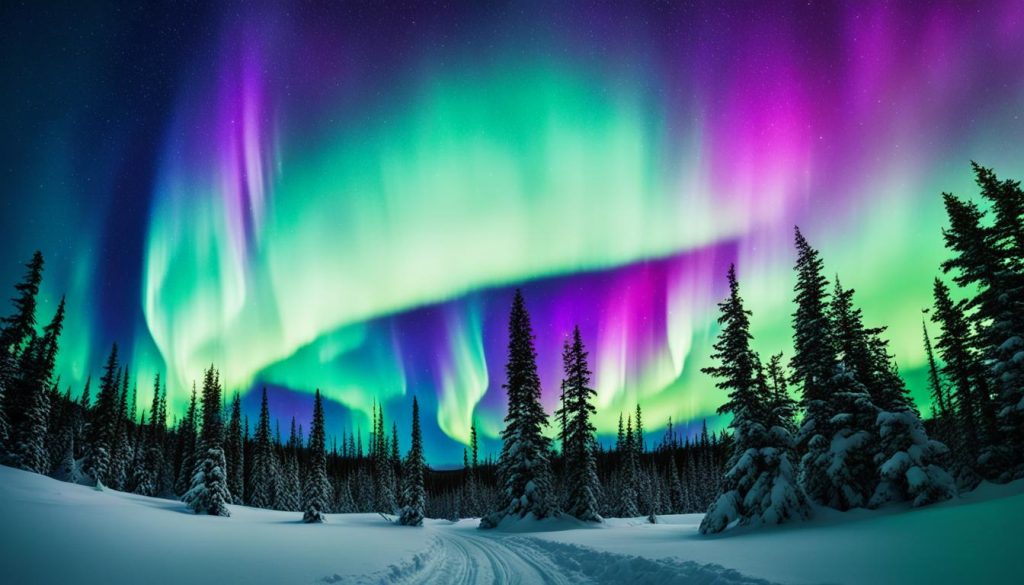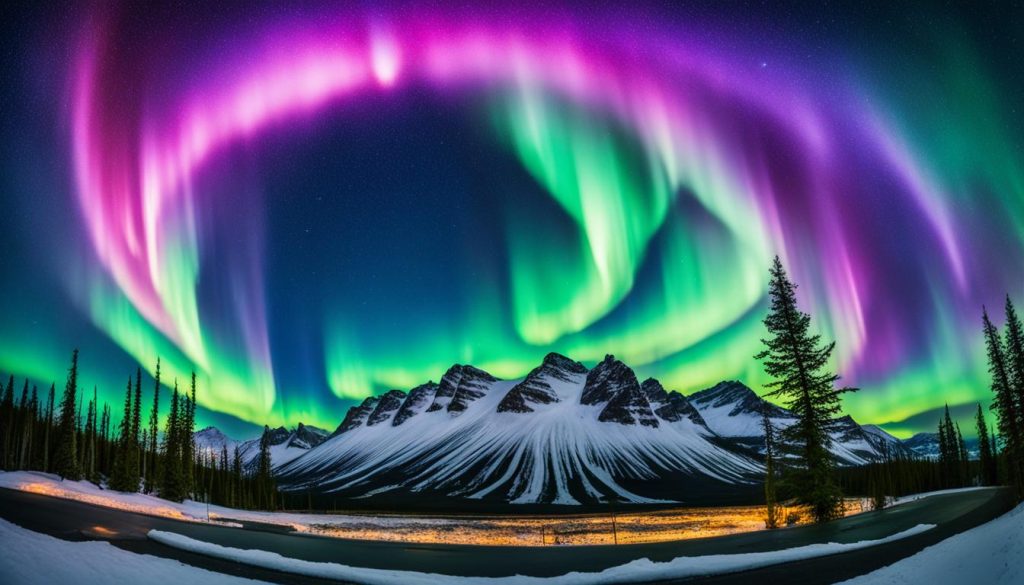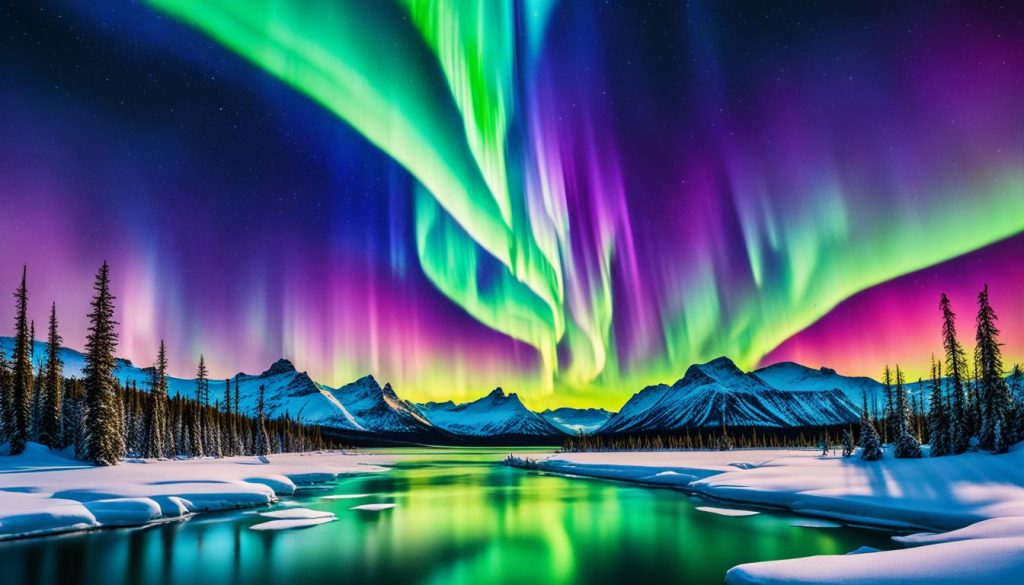Have you ever witnessed the mesmerizing dance of the northern lights, also known as the aurora borealis? This spectacular, colorful display of light is a natural phenomenon that has captivated people for centuries. But do you know what causes this celestial spectacle in the Arctic skies? Prepare to embark on a journey through the science and wonder of the northern lights.

Key Takeaways
- The northern lights are a breathtaking natural phenomenon caused by the interaction between the Sun’s solar particles and Earth’s magnetic field.
- The vibrant colors of the northern lights, including green, red, and blue, are created by the collision of charged particles with different gas molecules in the upper atmosphere.
- The best places to view the northern lights are in northern Canada and other Arctic regions, near the magnetic poles where the phenomenon is most intense.
- Solar activity, such as coronal mass ejections, can have a significant impact on the intensity and frequency of auroral displays.
- The northern lights have long held cultural significance and been the subject of myths and legends among indigenous populations in the Arctic regions.
But what is the driving force behind this cosmic lightshow? How can we better understand and predict the appearance of the northern lights? Let’s dive deeper into the science and secrets of this mesmerizing natural wonder.
What are the Northern Lights (Aurora Borealis)?
The northern lights, or aurora borealis, are a spectacular shimmering curtain of light in the night sky, high in Earth’s upper atmosphere. This colorful display is caused by energetic electrons from Earth’s magnetic field colliding with gases, making them glow. Auroras are a sign that something electric is happening in the space around Earth. They occur near the magnetic poles because of the shape of Earth’s magnetic field, which acts as a shield, redirecting the solar wind around the planet.
A Celestial Display in the Arctic Skies
The northern lights are a breathtaking celestial display in the Arctic skies, captivating viewers with their ever-changing patterns and vibrant colors. This natural phenomenon is a true marvel to witness, showcasing the dynamic relationship between Earth and the Sun.
Caused by Solar Particles Interacting with Earth’s Magnetic Field
The northern lights are the result of solar particles from the Sun interacting with Earth’s magnetic field. As these charged particles enter the upper atmosphere, they collide with gas molecules, causing them to emit the colorful light we see in the night sky.
How Auroras Form
The captivating northern lights, known as the auroras, are a testament to the intricate relationship between our planet and the Sun. This cosmic dance begins with the Sun, which continually blasts charged particles (electrons and protons) into the vast expanse of space, forming the solar wind. As this solar wind approaches Earth, it encounters a formidable force: our planet’s magnetic field.
Earth’s magnetic field acts as an invisible shield, redirecting the solar wind around our planet. However, as the magnetic field protects us from the onslaught of charged particles, it undergoes a remarkable transformation. The magnetic field lines are dragged and stretched, only to snap back like an elastic band, launching the charged particles down towards the Earth’s surface along the magnetic field lines.
It is this collision of charged particles with the gases in Earth’s upper atmosphere that gives rise to the stunning auroras. As the charged particles descend, they interact with the oxygen and nitrogen molecules in the atmosphere, causing them to emit tiny flashes of light that collectively form the mesmerizing displays of the auroras.
The Northern Lights (Aurora Borealis) Phenomenon
The northern lights, or aurora borealis, are a captivating natural phenomenon that occurs near Earth’s magnetic poles. These mesmerizing displays of light in the Arctic skies are a result of the complex interactions between the Sun’s solar particles and our planet’s magnetic field.
Occurrence Near Earth’s Magnetic Poles
Auroras can be observed almost every night in the northern sky, typically from August to May. The reason we see these vibrant lights in northern Canada is due to the unique connection between the Earth’s magnetic field and the space around it. The region where the “dragging, stretching, and snapping” of magnetic field lines occurs is directly linked to the north and south ends of our planet, creating the characteristic auroral ovals around the North and South Poles.
Best Viewing Times and Conditions
The northern lights are generally easier to see during the winter months, as the longer, darker night skies provide better viewing conditions. While auroras can be spotted year-round, the summer season’s brighter nights make them less visible to the naked eye. By understanding the optimal times and locations to observe this celestial phenomenon, viewers can increase their chances of witnessing the stunning display of the aurora borealis.
A Colorful Spectacle
The northern lights (aurora borealis) come in a mesmerizing array of colors, including vibrant green, red, and blue. These colorful spectacles in the Arctic skies are the result of the intricate interplay between the Sun’s charged particles and Earth’s magnetic field.
Green, Red, and Blue Auroras
The diverse colors of the northern lights are determined by the type of gas molecules that the charged particles from the solar wind interact with in the upper atmosphere. The most common green auroras are caused by oxygen molecules at lower altitudes. Rarer red auroras are produced by oxygen molecules at higher altitudes, while blue and purple auroras are the result of nitrogen molecules being excited by the incoming particles.
The Colors of the Northern Lights Explained
As the charged particles from the Sun’s solar wind interact with the different gas molecules in the ionosphere, the colors of the northern lights (aurora borealis) can shift and change dynamically. This mesmerizing colorful spectacle is a testament to the intricate relationship between Earth’s magnetic field and the constant activity on the Sun.
Where to See the Northern Lights (Aurora Borealis)
The best places to witness the captivating display of the northern lights (aurora borealis) are in the northern Canada and other Arctic regions, as these areas are situated near the magnetic poles where the auroras are most frequently observed. However, it’s important to note that occasional sightings in lower latitudes are not entirely uncommon, although they tend to be much rarer compared to the stunning displays seen in the higher northern latitudes.
The southern lights, also known as the aurora australis, are typically only visible over Antarctica, as they occur near the southern magnetic pole. The northern and southern lights are mirror images of each other, both created by the interaction between the Sun’s solar particles and Earth’s magnetic field.
Solar Activity and Auroral Displays
The intensity and frequency of the northern lights (aurora borealis) are closely tied to the Sun’s solar activity. The more active the Sun is, the more stunning the auroras will appear on Earth. Coronal mass ejections (CMEs), which are enormous expulsions of plasma and magnetic field from the Sun’s outermost atmosphere, can have a significant impact on auroral displays.
Coronal Mass Ejections and Their Impact
When a CME slams into Earth’s magnetosphere, it can trigger geomagnetic storms, causing the oval positioned above northern Canada to stretch further south, allowing the northern lights to be visible across a wider area. This increased solar activity can lead to more intense and colorful auroras, making them visible from lower latitudes that are typically outside the normal viewing zone.
More Active Sun, More Stunning Auroras
During periods of increased solar activity, such as the peak of the Sun’s 11-year solar cycle, the northern lights (aurora borealis) are more intense and can be seen from lower latitudes. This is because the enhanced solar wind and charged particles from the Sun have a greater impact on Earth’s magnetic field, leading to more dramatic and visually striking auroral displays.

The Science Behind the Northern Lights (Aurora Borealis)
Earth’s magnetic field, spanning thousands of kilometers in space, acts as a protective shield that safeguards the planet from the relentless solar wind. This vast magnetic field, in conjunction with the ionosphere—the uppermost layer of Earth’s atmosphere—plays a crucial role in the captivating phenomenon known as the northern lights (aurora borealis).
Earth’s Magnetic Field and the Ionosphere
As the charged particles from the solar wind interact with the gases in the ionosphere, they excite the molecules, causing them to emit the colorful lights we observe as the northern lights. This interplay between Earth’s magnetic field and the ionosphere is what creates the mesmerizing display in the Arctic skies.
Geomagnetic Storms and Auroral Substorms
Occasionally, events on the Sun, such as coronal mass ejections, can trigger geomagnetic storms that disrupt the flow of charged particles. These storms can lead to auroral substorms, where the northern lights appear to “dance” and change shape dramatically in the sky. Understanding the science behind these complex interactions helps us better predict and appreciate the beauty of this natural phenomenon.
Photographing the Northern Lights (Aurora Borealis)
Capturing the stunning beauty of the northern lights (aurora borealis) on camera requires specialized techniques and high-quality equipment. Whether you’re a seasoned photographer or a beginner, mastering the art of aurora photography can be a rewarding and exhilarating experience.
Tips for Capturing Stunning Auroral Images
To ensure you come away with breathtaking northern lights (aurora borealis) photographs, consider the following tips:
- Use a DSLR camera with a wide-angle lens to capture the vast expanse of the sky.
- Invest in a sturdy tripod to keep your camera steady during long exposures.
- Experiment with different camera settings, such as long exposure times, high ISO, and wide apertures, to collect as much light as possible.
- Time your shoots for the best viewing conditions, typically during the winter months when the nights are longer and darker.
- Scout locations with minimal light pollution for the most vibrant and clear auroral displays.
- Be prepared for the cold weather and dress appropriately to stay comfortable during your photography sessions.
Essential Camera Settings and Gear
To capture stunning northern lights (aurora borealis) photographs, it’s important to have the right photography gear and master the necessary camera settings:
| Camera Setting | Recommendation |
|---|---|
| Lens | Wide-angle lens (16-35mm or 24-70mm) for capturing the vast sky |
| Aperture | Wide aperture (f/2.8 or lower) to let in more light |
| Shutter Speed | Long exposure (10-30 seconds) to capture the movement of the auroras |
| ISO | High ISO (800-3200) to compensate for the low light conditions |
| Tripod | Sturdy and stable tripod to avoid blurry images |
By combining the right photography gear and mastering the essential camera settings, you’ll be well on your way to capturing stunning, frame-worthy images of the breathtaking northern lights (aurora borealis).

Cultural Significance and Mythology
The northern lights, or aurora borealis, have long held cultural significance and been the subject of myths and legends among indigenous populations in the Arctic regions. Many indigenous groups, such as the Inuit, have rich traditions and beliefs surrounding the auroras, often seeing them as spiritual or supernatural phenomena.
Indigenous Perspectives on the Northern Lights (Aurora Borealis)
For these cultures, the northern lights are more than just a natural spectacle; they are deeply intertwined with their worldviews and beliefs. The indigenous perspectives on the aurora borealis offer a unique and fascinating insight into how this celestial display has been perceived and interpreted throughout history.
Legends and Folklore Surrounding the Phenomenon
Legends and folklore from these Arctic cultures often describe the northern lights as the souls of the dead, dancing spirits, or other mystical explanations for the colorful celestial display. These myths and folklore showcase the deep cultural significance of the aurora borealis and how it has captivated the imagination of people living in the northern regions.
Understanding the cultural importance and mythological significance of the northern lights provides insight into how this natural phenomenon has been perceived and interpreted throughout history, enriching our appreciation and understanding of this breathtaking display in the Arctic skies.
Auroral Forecasting and Prediction
Predicting and monitoring the northern lights, or aurora borealis, is an important scientific endeavor. Space weather agencies and observatories closely track solar activity, such as coronal mass ejections, that can trigger geomagnetic storms and lead to more intense auroral displays.
Space Weather Monitoring
By monitoring the position and movement of the auroral oval, the region around the magnetic poles where the northern lights are most often seen, scientists can better forecast when and where the aurora borealis are likely to be visible. This information helps people plan their aurora-viewing experiences and allows for a deeper understanding of this natural phenomenon.
Auroral Oval and Auroral Oval Predictions
Advancements in auroral forecasting and prediction techniques have provided valuable insights into the behavior and patterns of the northern lights. Researchers continue to refine their models and data analysis to deliver more accurate and reliable auroral oval predictions, empowering both casual observers and dedicated aurora enthusiasts to maximize their chances of witnessing this captivating celestial display.
Conclusion
The northern lights (aurora borealis) are a captivating natural wonder that have enchanted people for generations. This celestial display in the Arctic skies is the result of a remarkable interaction between the Sun’s solar particles and Earth’s magnetic field, creating a vibrant and ever-changing light show. From the mesmerizing greens, reds, and blues to the deep cultural significance and scientific explanations behind this phenomenon, the northern lights continue to be a source of awe and fascination for people around the world.
As we delve deeper into the mysteries of the northern lights, our understanding of this natural spectacle only grows, fueling our curiosity and appreciation for the intricate dance between the Sun, Earth, and the atmosphere. The northern lights stand as a testament to the wonders of our planet and the cosmic forces that shape our world, captivating us with their beauty and inspiring us to continue exploring the frontiers of science and human knowledge.
Whether you’ve had the privilege of witnessing the northern lights firsthand or have only marveled at their captivating images, the enduring allure of this celestial display is undeniable. As we look to the future, the northern lights will undoubtedly continue to inspire wonder, foster scientific discovery, and remind us of the profound connection between our planet and the cosmos that surrounds it.

